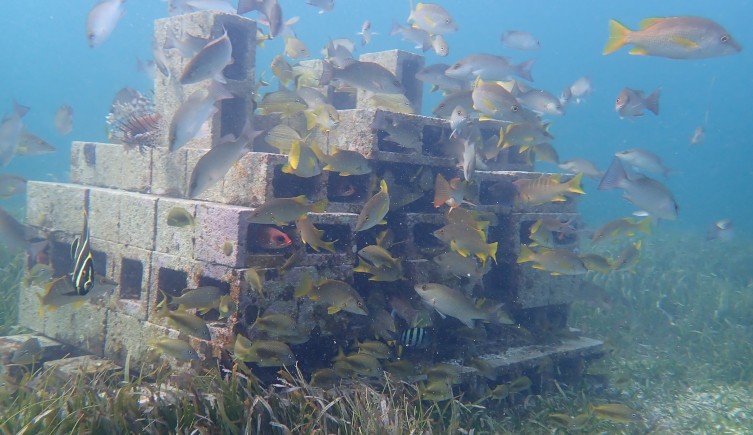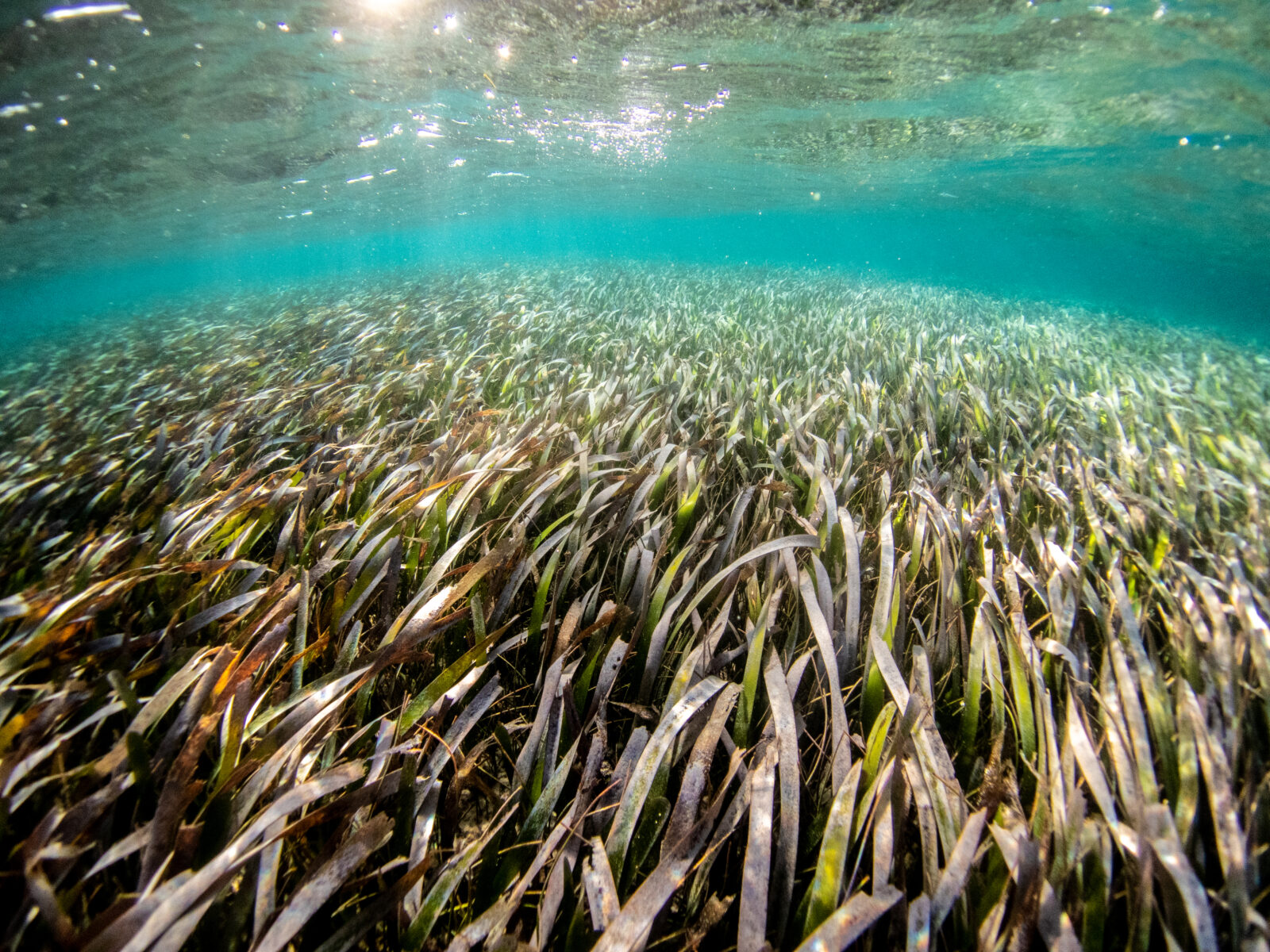Seagrass production around artificial reefs is resistant to human stressors

Artificial reefs might help to restore the ocean’s ability to fight against climate change. The reefs boost the productivity of seagrass meadows by attracting fish, which can improve the ability of these habitats to lock up more carbon dioxide beneath the waves. Breeze blocks placed in one of the ocean’s most endangered habitats provide an unexpected lift for fish. Seagrass meadows are found across the world, reaching from the tropics up into the lower reaches of the Arctic circle. They are incredibly valuable habitats, providing a nursery for young fish as well as sucking vast quantities of carbon dioxide from the atmosphere. However, with an area of seagrass the size of a football pitch being lost every 30 minutes, it’s more important than ever to find out how to turn things around. A new study in the Caribbean has shown that artificial reefs can help to bolster their growth in the tropics, even as threats such as fishing and nutrient pollution continue. Dr Jacob Allgeier, a co-author of the paper, says, ‘By attracting fish, whose faeces provide concentrated nutrients for the seagrass, the artificial reefs increase the primary production of the entire ecosystem.’ ‘We are now investigating how this cascades up the food web. The new energy has to go somewhere, so we are quantifying how it affects invertebrates and fish with our evidence suggesting that it is fuelling increases in both.’ The findings of the study were published in Proceedings of the Royal Society B. Artificial reefs and seagrass One of the biggest issues affecting seagrass is nutrient pollution, often from the release of human sewage. While the influx of nutrients can initially boost the growth of the meadows, it also promotes the growth of algae which reduces the amount of sunlight getting to the seagrass and harms it in the long run. Alongside fishing which causes levels of the fish faeces that fertilise the meadows to drop, it was thought that the combination of these two issues might work in unexpected ways to hinder the growth of seagrass. But the current study has revealed some surprising results. It has found that the productivity of seagrass in both disturbed and undisturbed meadows was increased by the presence of an artificial reef, while algae didn’t actually seem to pose an issue, even in areas where nutrient pollution was high. Mona Andskog, the PhD student who led the research, explains, ‘Artificial reefs built in seagrass create a positive feedback loop. They attract fish that use the reefs for shelter which, in turn, supply new nutrients from their faeces that fertilise the seagrass around the reef.’ ‘This increased primary production can increase invertebrate production by providing more food and shelter for invertebrates, which in turn provide more food for fishes.’ Experiments in Haiti, at some of the most fished sites included in the study, also showed that the artificial reefs were providing additional benefits to the fish. Large numbers of small fish were found at the site because of the difficulty in using nets around the reef, meaning that the overall biomass of fish was at times larger than in unfished areas measured elsewhere in the study. While artificial reefs present a promising option for tropical seagrasses, they’re likely to have a much more limited impact on temperate meadows. These waters already tend to have higher nutrient levels, meaning that any contribution the reef would made to overall growth would be small. The scientists now hope to explore how the placing of artificial reefs can affect seagrass ecosystems, as well as expanding their research to the Dominican Republic. ‘We will be testing how different configurations of artificial reef clusters can affect the production and fish community composition,’ Jacob says. ‘This includes the number of artificial reefs in each cluster, as well as their arrangement.’ ‘As with this research, we hope to simultaneously use the reefs to test fundamental questions about production in these highly impacted ecosystems as well as optimising the positive feedback that is initiated by the artificial reefs.’ More information: Mona A. Andskog et al, Seagrass production around artificial reefs is resistant to human stressors, Proceedings of the Royal Society B: Biological Sciences (2023). DOI: 10.1098/rspb.2023.0803 This story is republished courtesy of Natural History Museum. Read the original story here.
Seagrass meadows show resilience to ‘bounce back’ after die-offs

In Florida alone, thousands of acres of marine seagrass beds have died. Major seagrass die-offs also are occurring around the world. Stressors such as high temperature, hypersalinity and hypoxia or lack of oxygen affect seagrasses’ ability to resist and recover from these stressor-related mortality events or when disturbances lead to seagrass die-off events. Seagrass die-offs also are linked to exposure to sediment-derived hydrogen sulfide, a well-known phytotoxin that accumulates as seagrass ecosystems become more enriched in nutrients. While hydrogen sulfide intrusion into seagrass tissue is considered a leading cause of recurring mortality events, its effects on subsequent recruitment and distribution of new populations is unclear. Moreover, few studies have examined the ability of seagrass meadows‘ resilience to “bounce back” and recolonize in open bare patches. Researchers from Florida Atlantic University, in collaboration with the South Florida Water Management District, Coastal Ecosystems Division, examined if porewater hydrogen sulfide prevents Thalassia testudinum, a dominant tropical Atlantic-Caribbean marine seagrass known as turtlegrass, from recruiting into unvegetated sediment in Florida Bay. The bay is an estuary that covers about 1,100 square miles between the southern tip of Florida and the Florida Keys and is one of the largest global contiguous seagrass systems. Since the 1980s, seagrass meadows in Florida Bay have experienced repeated biomass losses, including massive die-off events of turtlegrass, which typically occur during high temperature and salinity conditions in the northcentral and western bay. The bay provided an excellent case-study site due to high porewater hydrogen sulfide and expansive unvegetated areas adjacent to intact meadows that are recolonized by turtlegrass recruits following morality events. For the study, researchers examined the leaf, stems and root tissue of turtlegrass in Florida Bay to establish tissue exposure to hydrogen sulfide in new recruits and measured internal hydrogen sulfide and oxygen dynamics using cutting-edge microsensors in the field and stable isotope analyses. Results, published in the journal Aquatic Botany, provide evidence that turtlegrass can successfully recruit into open bare sediment following die-off events due to biomass partitioning—a process by which plants divide their energy among their leaves, stems, roots and reproductive parts—during early development, young root structure, and an ability to efficiently oxidize internally, which lowers hydrogen sulfide exposure. However, recovery of seagrass meadows takes time. “Long-term monitoring programs in Florida Bay indicate that the time frame for full recovery of turtlegrass meadows after major die-off events is at least a decade,” said Marguerite Koch, Ph.D., senior author and a professor of biological sciences in FAU’s Charles E. Schmidt College of Science. “Therefore, preventing large-scale seagrass mortality events should be the management goal, particularly as global warming and associated stressors are likely to get more extreme in the future.” Findings of the study indicate that recruiting shoot resistance to hydrogen sulfide exposure is linked to adequate oxidation of internal tissue during the day through late afternoon via photosynthesis and internal plant oxidation promoted by water column oxygen diffusion into the leaves at night, driven at times by tides. Limited belowground root development in new recruits potentially constrains microbial community development and associated sulfate reduction that decrease hydrogen sulfide intrusion into roots and negatively affecting sensitive growing tissue at the base of the seagrass leaves. “Seagrass meadows sustain coastal ecosystems by protecting against erosion, maintaining water quality and providing habitat and food for many marine species and organisms,” said Koch. “Because of their importance in coastal communities, the current decline of seagrass ecosystems on a global scale across geographic regions is a concern.” More information: K. MacLeod et al, Resilience of recruiting seagrass (Thalassia testudinum) to porewater H2S in Florida Bay, Aquatic Botany (2023). DOI: 10.1016/j.aquabot.2023.103650

